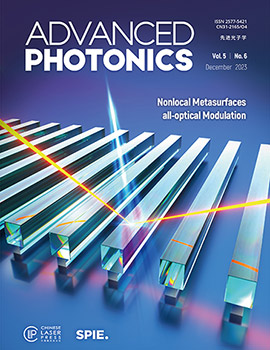Overcoming the limitations of 3D sensors with wide field of view metasurface-enhanced scanning lidar
IF 18.8
1区 物理与天体物理
Q1 OPTICS
引用次数: 0
Abstract
Abstract. Lidar, a technology at the heart of autonomous driving and robotic mobility, performs 3D imaging of a complex scene by measuring the time of flight of returning light pulses. Many technological challenges, including enhancement of the observation field of view (FoV), acceleration of the imaging frame rate, improvement of the ambiguity range, reduction of fabrication cost, and component size, must be simultaneously addressed so that lidar technology reaches the performance needed to strongly impact the global market. We propose an innovative solution to address the problem of wide FoV and extended unambiguous range using an acousto-optic modulator that rapidly scans a large-area metasurface deflector. We further exploit a multiplexing illumination technique traditionally deployed in the context of telecommunication theory to extend the ambiguity range and to drastically improve the signal-to-noise ratio of the measured signal. Compacting our metasurface-scanning lidar system to chip-scale dimension would open new and exciting perspectives, eventually relevant to the autonomous vehicles and robotic industries.利用宽视场元表面增强扫描激光雷达克服3D传感器的局限性
摘要激光雷达是自动驾驶和机器人移动的核心技术,它通过测量返回光脉冲的飞行时间来对复杂场景进行3D成像。必须同时应对许多技术挑战,包括增强观测视场(FoV)、加速成像帧速率、提高模糊范围、降低制造成本和部件尺寸,以便激光雷达技术达到对全球市场产生强大影响所需的性能。我们提出了一种创新的解决方案,使用声光调制器快速扫描大面积超表面偏转器来解决宽FoV和扩展明确范围的问题。我们进一步利用了传统上在电信理论背景下部署的多路复用照明技术,以扩展模糊范围并大幅提高测量信号的信噪比。将我们的元表面扫描激光雷达系统压缩到芯片规模将开辟新的令人兴奋的前景,最终与自动驾驶汽车和机器人行业相关。
本文章由计算机程序翻译,如有差异,请以英文原文为准。
求助全文
约1分钟内获得全文
求助全文
来源期刊

Advanced Photonics
OPTICS-
CiteScore
22.70
自引率
1.20%
发文量
49
审稿时长
18 weeks
期刊介绍:
Advanced Photonics is a highly selective, open-access, international journal that publishes innovative research in all areas of optics and photonics, including fundamental and applied research. The journal publishes top-quality original papers, letters, and review articles, reflecting significant advances and breakthroughs in theoretical and experimental research and novel applications with considerable potential.
The journal seeks high-quality, high-impact articles across the entire spectrum of optics, photonics, and related fields with specific emphasis on the following acceptance criteria:
-New concepts in terms of fundamental research with great impact and significance
-State-of-the-art technologies in terms of novel methods for important applications
-Reviews of recent major advances and discoveries and state-of-the-art benchmarking.
The journal also publishes news and commentaries highlighting scientific and technological discoveries, breakthroughs, and achievements in optics, photonics, and related fields.
 求助内容:
求助内容: 应助结果提醒方式:
应助结果提醒方式:


